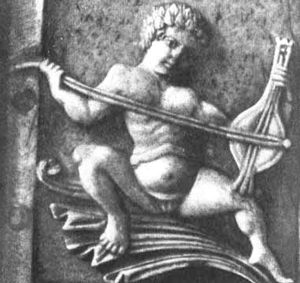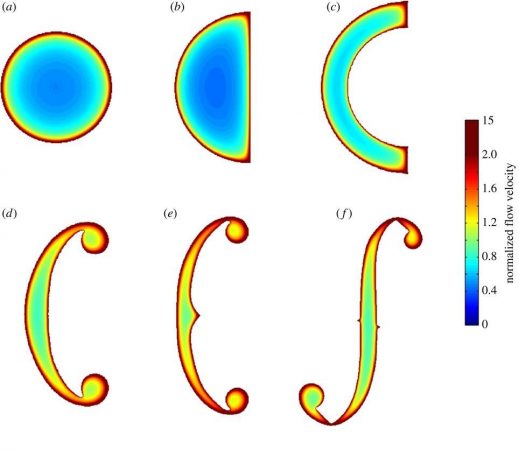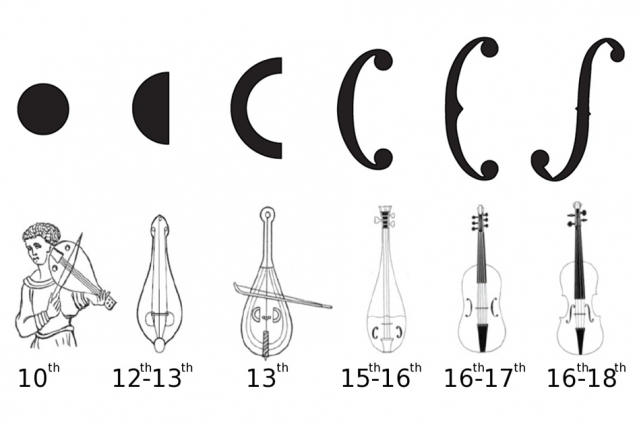The lost history behind violins and their f-shaped holes
Instruments have gone through hundreds and sometimes thousands of years of refining to the form we recognise them in today. So why do guitars have a big circular hole in the centre whilst violins have fanciful f-shapes on either side of their strings?

Over 1000 years ago the fiddle, or ‘fithele’, was spreading across Europe as string instruments became more complex and sought after. The instrument spead through Europe as a progression of the Byzantine ‘lira‘, a bowed string instrument favoured by the Byzantine Empire in the 9th century. The lira itself was developed from the Arab bowed instrument – the rebab. The fiddle found itself an established instrument in Western Europe by the 12th Century – appearing in carvings and illustrations from 900 A.D. onward.
In it’s earliest iterations the fiddle represented, in many ways, what we know the violin to look and sound like today but in a much more rudimentary form. More often than not the earliest iterations would have an ovular design and would commonly have a shorter neck than the violin we recognise today. The neck has been expanded over the past century to create a larger range of notes and the body, whilst retaining it’s oval look, comes in at the centre as most contemporary string instruments do.
As body of the fiddle evolved from it’s lira-based beginnings so did the geometry of it’s sound hole. Early liras featured two holes on either side of the strings but they were often circular. As the understanding of air resonance in string instruments became more sophisticated the design of fiddles underwent gradual changes through the eras helping the small but highly influential instrument to grow in capability.

The fiddle underwent a big evolution in the 15th and 16th centuries and the lira de braccio was created, becoming a prominent instrument of the Renaissance. Developed in Italy, the lira de braccio was used by poet-musicians to accompany their narrative poetry. The lira de braccio refined the sound of the medieval fiddle and largely resembles the modern violin, laying the groundwork for the instrument we now know and love. It was highly influential in advancing musical culture.
The Renaissance instrument had a wide flat fingerboard which allowed for the playing of chords, using strongly curved bows. But another feature that set it apart from it’s predecessors were the s-shaped holes which eventually evolved into the f-shape that we recognise today. It was a slow development that had been taking place since the 12th century when the fiddle was uniquely crafted with half moon and c-shapes rather than the round hole typical of bodied string instruments.
Recent research by Massachusetts Institute of Technology (MIT), published in the Royal Society of Publishing (RSP), found that air flow at the perimeter of sound holes conducts acoustics at a much greater rate. The further into the hole the sound gets the less it permeates, meaning that the size of the hole doesn’t necessarily impact the volume of sound whilst the edges of a sound hole allow for much more acoustic resonance.
There was “an increasing trend in radiated air resonance power having occurred over the classical Cremonese period from roughly 1550 (the Late Renaissance) to 1750 (the Late Baroque Period)”. The research team at MIT found that during this period the f-shaped holes grew increasingly longer. As the f-holes became longer and more refined so did their radiated acoustic power.

Whilst it makes acoustic sense, the study suggests that the shape may not have been by design but in part an accident. Writing for MIT News, Jennifer Chu says: “The researchers worked the measurements from hundreds of Cremonese-era violins into an evolutionary model, and found that any change in design could reasonably be explained by natural mutation – or, in this case, craftsmanship error.”
Essentially; the elongation of the sound holes may have just been defects in each instrument as craftsmen tried to replicate earlier designs that they found preferable. The researchers found that trying to carve the sound hole using a knife in thin wood there was an error margin of roughly 2%, which through patterns could have led to longer sound holes with each instrument.
Acoustician and part of the research team at MIT, Nicholas Makris says: “We found that if you try to replicate a sound hole exactly from the one you made, you’ll always have a little error… People had to be listening, and had to be picking things that were more efficient, and were making good selection of what instrument to replicate. Whether they understood, ‘Oh, we need to make [the sound hole] more slender,’ we can’t say. But they definitely knew what was a better instrument to replicate.
The size of the instrument played a part in it’s design as well, being a one handed instrument made to be possible to play whilst standing. Chu adds: “an elongated sound hole takes up little space on the violin, while still producing a full sound – a design that the researchers found to be more power-efficient than the rounder sound holes of the violin’s ancestors, such as medieval fiddles, lyres, and rebecs.”
In a time before electric amplification acoustic resonance was incredibly important. Particularly as music grew in popularity and cultural significance, the ability to play to larger audiences was sought after. Makris and his MIT colleagues found that f-holes have “twice the sonic power… of the circular holes of the fithele” (early fiddle).
The study was undertaken with analysis of 470 instruments made between 1560 and 1750 to examine the advancement and differences in sound holes that led to the famed f-hole shape we synonymise with violins today. You can read the full study here: https://royalsocietypublishing.org/doi/full/10.1098/rspa.2014.0905
